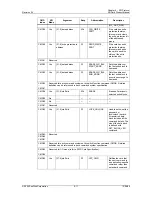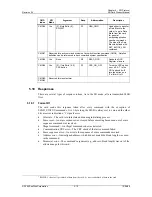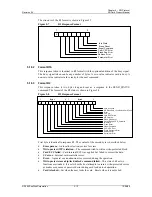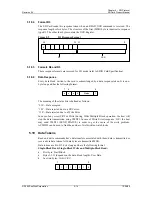
Chapter 4 – SD Card Protocol Description
Revision 2.2
SanDisk SD Card Product Manual
© 2004 SanDisk Corporation
4-45
12/08/04
If the SD Card does not have a free data receive buffer, it indicates this condition by pulling
down the data line to
low
. The card stops pulling down the data line as soon as at least one
receive buffer for the defined data transfer block length becomes free. This signaling does
not give any information about the data write status that must be polled by the host.
Multiple Block Write
In multiple block write mode, the card expects continuous flow of data blocks following
the initial host write command. The data flow is terminated by a stop transmission
command (CMD12). The
Multiple Block Write Command
timin
g
diagram describes the
timing of the data blocks with and without card busy signal.
Multiple Block Write Command Timing
In write mode, the stop transmission command works similarly to the stop transmission
command in the Read Mode. The following figure describes the timing of the stop
command in different card states.
Stop Transmission During Data Transfer from the Host
The card will treat a data block as successfully received and ready for programming only if
the CRC data of the block was validated and the CRC status token sent back to the host.
The figure below is an example of an interrupted (by a host stop command) attempt to
transmit the CRC status block. The sequence is identical to all other stop transmission
examples. The end bit of the host command is followed, on the data line, with one more
data bit, end bit and two Z clock for switching the bus direction. The received data block in
this case is considered incomplete and will not be programmed.
Stop Transmission during CRC Status Transfer from the Card
All previous examples dealt with the scenario of the host stopping the data transmission
during an active data transfer. The following two diagrams describe a scenario of receiving
the stop transmission between data blocks. In the first example, the card is busy
programming the last block while the card is idle in the second block as shown in the
second diagram. However, there remains un-programmed data blocks in the input buffers.
These blocks are being programmed as soon as the stop transmission command is received
and the card activates the busy signal.
CMD E Z
Busy
DAT Z Z P*P
S
Z
E
P
P
P
P P
P
P
P
P
N
WR
E S
Card
Response
N
WR
Write Data
CRC Status
Z P
*******************
E Z
S
P*P
Data+CRC
E Z Z S Status
L*L
P P P P
*********************
Data+CRC
E Z Z S Status
P
P*P
Write Data
CRC Status
N
WR
CMD S T
DAT
Z
Z
E
S T
Z Z
Card Response
Z
Content
*********
Z Z P
S
E Z Z
E
Card is Programming
Host Command
Content
P* ****P
T Content
CRC
CRC
Z
Host Command
N
CR
Cycles
D D
D D D
Z
S
D
D D D D E
L
Z
CMD S T
DAT
Z
Z
E
S T
Z Z
Card Response
Z
Content
*********
Z Z P
S
E Z Z
E
Card is Programming
Host Command
Content
P* ****P
T Content
CRC
CRC
Z
Host Command
N
CR
Cycles
D D
D D Z
Z
S
D
Z S
E
L
Z
Data Block
Status
CRC Status
















































